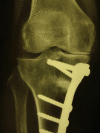Opening wedge tibial osteotomy for large varus deformity with Ceraver resorbable beta tricalcium phosphate wedges
- PMID: 19795122
- PMCID: PMC2899356
- DOI: 10.1007/s00264-009-0875-1
Opening wedge tibial osteotomy for large varus deformity with Ceraver resorbable beta tricalcium phosphate wedges
Abstract
The results in 53 knees that had been treated by proximal tibial opening-wedge osteotomy for large varus deformity and osteoarthritis of the medial compartment were evaluated after a mean length of follow-up of ten years (range, 8-12 years). We used a porous beta-tricalcium phosphate (beta-TCP) wedge because it is resorbable and osteoinductive. All osteotomies were completely consolidated and complete osseointegration of the remnant of the beta-TCP wedge took place. However, after a mean maximum follow-up of ten years none of the cases showed complete resorption. After ten years, 40 (81%) of the 53 knees had an excellent or good result, and in 13 knees there was recurrent pain for which six had an arthroplasty. Although the results deteriorated with time, time was not the only determinant of the result. Alignment, measured as the hip-knee-ankle angle on radiographs of the whole limb that were made with the patient bearing weight, was also a determinant of long-term results. The best results were obtained in the knees that had a hip-knee-ankle angle of 183-186 degrees. In these knees, there was no pain and no progression of the arthrosis in either the medial or the lateral tibiofemoral compartment. Of the three knees that had an angle of more than 186 degrees, all five had progressive degenerative changes in the lateral compartment. In the undercorrected knees (an angle of less than 183 degrees), the results were less satisfactory, and there was a tendency toward recurrence of the varus deformity and progression of the arthritis of the medial compartment. However, when the correction was insufficient the deterioration was slow. Therefore, proximal tibial osteotomy is a very suitable operation even for patients who have gonarthrosis of the medial compartment and a large varus deformity. Although, a rigidly standardised and precise operative technique is required as well as accurate radiographic measurements of the mechanical axis of the limb because exact postoperative alignment is the prerequisite for the longest possible period of relief of symptoms after osteotomy, and this exact alignment is difficult to obtain for patients with large varus deformity.
Similar articles
-
Proximal tibial osteotomy for osteoarthritis with varus deformity. A ten to thirteen-year follow-up study.J Bone Joint Surg Am. 1987 Mar;69(3):332-54. J Bone Joint Surg Am. 1987. PMID: 3818700
-
Lateral Opening-wedge Distal Femoral Osteotomy: Pain Relief, Functional Improvement, and Survivorship at 5 Years.Clin Orthop Relat Res. 2015 Jun;473(6):2009-15. doi: 10.1007/s11999-014-4106-8. Epub 2014 Dec 24. Clin Orthop Relat Res. 2015. PMID: 25537806 Free PMC article.
-
High tibial osteotomy in medial compartment osteoarthritis of knee: functional outcome of medial open wedge and lateral closing wedge osteotomies-How does the outliers fare in the medium term?Musculoskelet Surg. 2023 Sep;107(3):313-322. doi: 10.1007/s12306-022-00756-9. Epub 2022 Aug 20. Musculoskelet Surg. 2023. PMID: 35986855
-
Closing wedge osteotomy of the tibia and the femur in the treatment of gonarthrosis.Int Orthop. 2010 Feb;34(2):173-84. doi: 10.1007/s00264-009-0883-1. Epub 2009 Oct 15. Int Orthop. 2010. PMID: 19830426 Free PMC article. Review.
-
Results of high tibial osteotomy: review of the literature.Int Orthop. 2010 Feb;34(2):155-60. doi: 10.1007/s00264-009-0889-8. Epub 2009 Oct 17. Int Orthop. 2010. PMID: 19838706 Free PMC article. Review.
Cited by
-
Bovine xenograft locking Puddu plate versus tricalcium phosphate spacer non-locking Puddu plate in opening-wedge high tibial osteotomy: a prospective double-cohort study.Int Orthop. 2013 May;37(5):819-26. doi: 10.1007/s00264-013-1817-5. Epub 2013 Feb 15. Int Orthop. 2013. PMID: 23412369 Free PMC article.
-
Monoplanar versus biplanar medial open-wedge proximal tibial osteotomy for varus gonarthrosis: a comparison of clinical and radiological outcomes.Knee Surg Sports Traumatol Arthrosc. 2013 Dec;21(12):2689-95. doi: 10.1007/s00167-012-2040-4. Epub 2012 May 30. Knee Surg Sports Traumatol Arthrosc. 2013. PMID: 22644071
-
Clinical outcomes of autologous adipose-derived mesenchymal stem cell combined with high tibial osteotomy for knee osteoarthritis are correlated with stem cell stemness and senescence.J Transl Med. 2024 Nov 18;22(1):1039. doi: 10.1186/s12967-024-05814-3. J Transl Med. 2024. PMID: 39558365 Free PMC article. Clinical Trial.
-
Reconstruction of Load-Bearing Segmental Bone Defects Using Carbonate Apatite Honeycomb Blocks.ACS Mater Au. 2023 Apr 26;3(4):321-336. doi: 10.1021/acsmaterialsau.3c00008. eCollection 2023 Jul 12. ACS Mater Au. 2023. PMID: 38090126 Free PMC article.
-
Safety of simultaneous versus staged bilateral opening-wedge high tibial osteotomy with locked plate and immediate weight bearing.Int Orthop. 2020 Jan;44(1):109-117. doi: 10.1007/s00264-019-04385-z. Epub 2019 Aug 5. Int Orthop. 2020. PMID: 31385014
References
-
- Fujisawa Y, Masuhara K, Shiomi S. The effect of high tibial osteotomy on osteoarthritis of the knee. An arthroscopic study of 54 knee joints. Orthop Clin North Am. 1979;210:585–588. - PubMed
-
- Grelsamer RP. Unicompartmental osteoarthritis of the knee. J Bone Jt Surg [Am] 1995;77:278–281. - PubMed
-
- Hernigou P, Medevielle D, Debeyre J, Goutallier D. Proximal tibial osteotomy for osteoarthritis with varus deformity. J Bone Jt Surg [Am] 1987;69:332–354. - PubMed
MeSH terms
Substances
LinkOut - more resources
Full Text Sources


